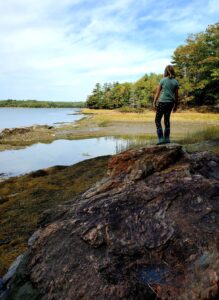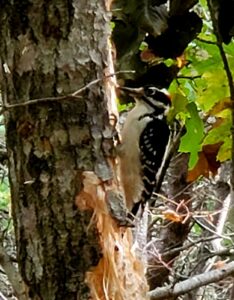October 21: The Wide World of Woodpeckers

The Tidal Estuary at Cross River Preserve
Due to of the pandemic, my daughter’s Wednesday schedule of remote schooling allows us the flexibility to get outside in the afternoons for a hike. Every Wednesday I let her look at a map and pick the BRLT preserve she wants to visit. Last Wednesday she picked Cross River Preserve, which is found right off of busy route 27 in Boothbay. In the parking lot sounds of cars zipping by are inescapable, but as you follow the meandering woodland trail down to the tidal estuary of the Cross River, the sounds of birds take over.
Such was the case that afternoon when we heard the unmistakable tapping of a woodpecker working on retrieving a meal from a trail-side tree. It didn’t take my daughter long to spot the Hairy Woodpecker on a dead oak tree that it was busily pecking apart, looking for tasty insects to eat. Woodpeckers often become so focused while eating that they don’t notice or pay much attention to hikers, making them great birds for young and old nature enthusiasts to observe in action. My daughter and I stood still for over 20 minutes just watching the bird do its work and taking some photos from a distance.

Hairy Woodpecker at Cross River Preserve
Maine is home to 9 species of woodpecker, and in our area some are more common than others. We were watching what I would consider to be our most common, the Hairy Woodpecker. This is not to be confused with the Downy Woodpecker, which bears a close resemblance. We could tell it was a Hairy because of its larger body and bill size. Both woodpeckers have black and white coloration with a bright red patch on the back of their heads. On BRLT preserves we also see (and hear) Pileated Woodpeckers, Northern Flickers, Yellow-Bellied Sapsuckers, and Red-Bellied Woodpeckers.
Each of these woodpeckers has different preferences for feeding, with most drilling holes into wood to expose hidden delicacies such as Carpenter Ants. While most woodpeckers find meals up high in trees, Northern Flickers specialize in foraging at ground level. The Yellow-Bellied Sapsucker also has a distinct means of feeding. Preferring a diet of tree sap, this woodpecker creates shallow holes along the bark of a tree in which the sap pools. The apple trees near BRLT’s Oak Point Farm kiosk have lines upon lines of the unmistakable “sap wells” of the Yellow-Bellied Sapsucker up and down their bark.

Dead Oak Tree with Signs of Woodpecker Feeding
All of our woodpeckers are cavity nesters, meaning that they raise their young in a large hole in a tree. These tree cavities will be used to raise woodpecker young for many years, and if unoccupied, may be taken up by cavity nesting songbirds (such as our state bird, the Black-capped Chickadee), or by opportunist mammals such as bats and raccoons.
When attracting a mate in the spring, the male woodpecker uses its beak to drum a unique pattern. In order for his call to reach far and wide, different species of male woodpeckers take advantage of different surfaces beyond wood for drumming, such as metal street signs.
Most of our woodpeckers here in the Boothbay region remain year-round, with the exception of While Yellow Bellied Sapsuckers and Northern Flickers who move south as their food sources freeze over or get covered with snow. The year-round varieties stay busy drilling for grubs and larvae that are hidden deep within trees, supplementing their diet with nuts and berries. If you want to bring woodpeckers to your yard this winter, it is as easy as hanging up a suet feeder. My daughter and I do this every year so that we can pass our snow days watching birds from the coziness of our warm home.




